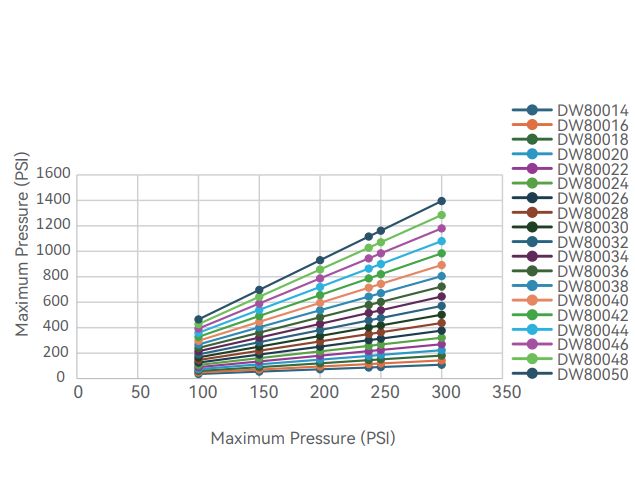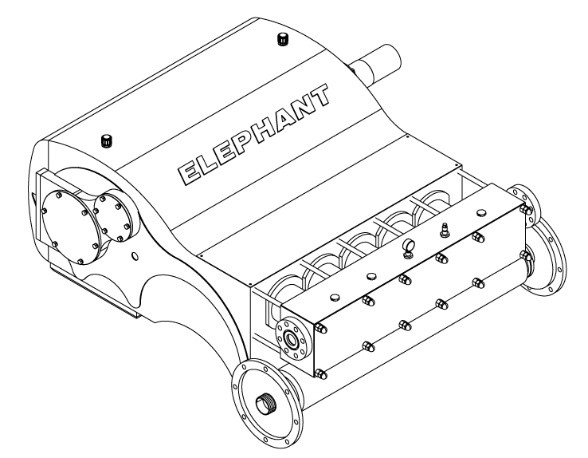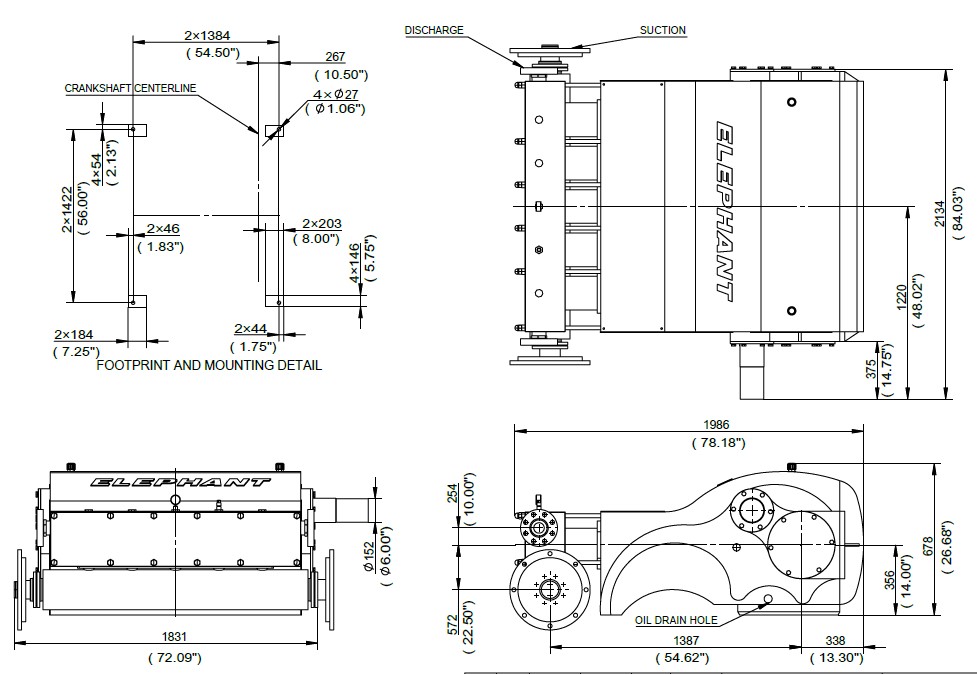Model :
DW-800Type :
Plunger PumpStroke :
7.0 Inches / 177.8 mmCylinder Diameter :
44-159mmFlow :
136.3-5280.1LPM/36-1395GPMPressure :
6-69MPaShipping Port :
Shanghai Port, ChinaWarranty :
12 MonthsSpecifications:
| Design Standard | API-674, Third Edition |
| Configuration | Horizontal quintuple Plunger |
| Number of Plungers | 5 |
| Continuous Duty | 650 BHP |
| Intermittent Duty | 800 BHP |
| Stroke Length | 7.0 Inches / 177.8 mm |
| Frame Load Rating | 27,500 lbs / 12474 kg |
| Pump Weight (Average) | 13,000 lbs / 5896.8 kg |
| Intermittent Duty Speed Rating | 300 RPM |
| Continuous Duty Speed Rating | 240 RPM |
| Minimum Speed | 100 RPM |
| Mechanical Efficiency | 90% |
| Lubrication System | Splash, Gravity Return |
| Lubrication System (Optional) | Pressurized |
| Crankcase Oil Capacity | 38 Gallons / 143.83 L |
| Lube Oil Type | SAE 30 |
| Fluid Temperature Range | -20~350°F/-28~176°C |
| Valve Type | Disc Valve / Wear-resistant Valve |
Performance Data (Metric):
| Pump Model |
Plunger Diameter (mm) |
Displacement (L/REV) |
Maximum Pressure (MPa) |
Pump Capacity (LPM)@Input Speed (RPM) | |||||
| 100 | 150 | 200 | 240 | 250 | 300 | ||||
| DW80014 | 44 | 1.3793 | 69 | 136.3 | 208.2 | 276.3 | 329.3 | 344.4 | 412.6 |
| DW80016 | 51 | 1.8017 | 60 | 181.7 | 268.7 | 359.6 | 431.5 | 450.4 | 541.3 |
| DW80018 | 57 | 2.2801 | 48 | 227.1 | 340.7 | 454.2 | 548.8 | 571.5 | 685.1 |
| DW80020 | 64 | 2.8149 | 39 | 280.1 | 423.9 | 564 | 673.7 | 704 | 844.1 |
| DW80022 | 70 | 3.4061 | 32 | 340.7 | 511 | 681.3 | 817.6 | 851.6 | 1022 |
| DW80024 | 76 | 4.0537 | 27 | 405 | 609.4 | 810 | 972.7 | 1014.4 | 1215 |
| DW80026 | 83 | 4.7574 | 23 | 476.9 | 715.4 | 950 | 1143.1 | 1188.5 | 1426.9 |
| DW80028 | 89 | 5.5174 | 20 | 552.6 | 828.9 | 1105.2 | 1324.8 | 1377.7 | 1654 |
| DW80030 | 95 | 6.3338 | 17 | 632.1 | 950 | 1268 | 1521.6 | 1582.1 | 1900.1 |
| DW80032 | 102 | 7.2066 | 15 | 719.2 | 1082.5 | 1442.1 | 1729.7 | 1801.7 | 2161.2 |
| DW80034 | 108 | 8.1355 | 13 | 813.8 | 1218.8 | 1627.6 | 1953.1 | 2032.5 | 2441.3 |
| DW80036 | 114 | 9.1207 | 12 | 912.2 | 1366.4 | 1824.4 | 2187.7 | 2278.6 | 2736.6 |
| DW80038 | 121 | 10.1623 | 11 | 1014.4 | 1525.4 | 2032.5 | 2437.5 | 2539.7 | 3046.9 |
| DW80040 | 127 | 11.2604 | 10 | 1124.1 | 1688.1 | 2252.1 | 2702.5 | 2816 | 3376.2 |
| DW80042 | 133 | 12.4144 | 9 | 1241.5 | 1862.2 | 2483.0 | 2978.8 | 3103.7 | 3724.4 |
| DW80044 | 140 | 13.6249 | 8 | 1362.6 | 2043.9 | 2725.2 | 3270.2 | 3406.5 | 4087.8 |
| DW80046 | 146 | 14.8917 | 7 | 1487.5 | 2233.2 | 2978.8 | 3573.0 | 3724.4 | 4466.3 |
| DW80048 | 152 | 16.2149 | 7 | 1620.0 | 2433.8 | 3243.7 | 3891.0 | 4053.7 | 4863.7 |
| DW80050 | 159 | 17.5942 | 6 | 1760 | 2638.1 | 3520.1 | 4224.1 | 4398.2 | 5280.1 |
Performance Data:
| Pump Model |
Plunger Diameter (in) |
Displacement (GAL/REV) |
Maximum Pressure (PSI) |
Pump Capacity (GPM)@Input Speed (RPM) | |||||
| 100 | 150 | 200 | 240 | 250 | 300 | ||||
| DW80014 | 1.75 | 0.3644 | 10000 | 36 | 55 | 73 | 87 | 91 | 109 |
| DW80016 | 2 | 0.476 | 8750 | 48 | 71 | 95 | 114 | 119 | 143 |
| DW80018 | 2.25 | 0.6024 | 6920 | 60 | 90 | 120 | 145 | 151 | 181 |
| DW80020 | 2.5 | 0.7437 | 5600 | 74 | 112 | 149 | 178 | 186 | 223 |
| DW80022 | 2.75 | 0.8999 | 4630 | 90 | 135 | 180 | 216 | 225 | 270 |
| DW80024 | 3 | 1.071 | 3890 | 107 | 161 | 214 | 257 | 268 | 321 |
| DW80026 | 3.25 | 1.2569 | 3310 | 126 | 189 | 251 | 302 | 314 | 377 |
| DW80028 | 3.5 | 1.4577 | 2860 | 146 | 219 | 292 | 350 | 364 | 437 |
| DW80030 | 3.75 | 1.6734 | 2490 | 167 | 251 | 335 | 402 | 418 | 502 |
| DW80032 | 4 | 1.904 | 2190 | 190 | 286 | 381 | 457 | 476 | 571 |
| DW80034 | 4.25 | 2.1494 | 1940 | 215 | 322 | 430 | 516 | 537 | 645 |
| DW80036 | 4.5 | 2.4097 | 1730 | 241 | 361 | 482 | 578 | 602 | 723 |
| DW80038 | 4.75 | 2.6849 | 1550 | 268 | 403 | 537 | 644 | 671 | 805 |
| DW80040 | 5 | 2.975 | 1400 | 297 | 446 | 595 | 714 | 744 | 892 |
| DW80042 | 5.25 | 3.2799 | 1270 | 328 | 492 | 656 | 787 | 820 | 984 |
| DW80044 | 5.5 | 3.5997 | 1160 | 360 | 540 | 720 | 864 | 900 | 1080 |
| DW80046 | 5.75 | 3.9344 | 1060 | 393 | 590 | 787 | 944 | 984 | 1180 |
| DW80048 | 6 | 4.284 | 970 | 428 | 643 | 857 | 1028 | 1071 | 1285 |
| DW80050 | 6.25 | 4.6484 | 900 | 465 | 697 | 930 | 1116 | 1162 | 1395 |
Standard connection sizes:
| Pump Model | Suction (in) | Discharge(in) |
| DW80014-DW80020 | 4.0 | 3.0 |
| DW80014-DW80024 | 6.0 | 3.0 |
| DW80026-DW80036 | 8.0 | 4.0 |
| DW80038-DW80042 | 10.0 | 6.0 |
| DW80044-DW80050 | 12.0 | 6.0 |
Fluid cylinder materials:
| Fluid cylinder materials | Cast |
| Carbon Steel | N/A |
| Hi-Strength Carbon Alloy Steel | |
| 304 / 316L / 17-4PH / 2205 / 2507 Stainless Steel |
*Special materials are available upon request


Engineering dimensional outline


FAQ
1. What is a chemical injection pump?
A chemical injection pump is a specialized device designed for transporting chemical agents, widely used in fluid management systems across industrial sectors. Its primary function is to deliver various chemical media to designated locations with precise control over flow rate and pressure, meeting the demands of production processes. These pumps typically feature high-precision adjustment capabilities, adapting to complex requirements under diverse operating conditions while ensuring safety and stability throughout the delivery process. Chemical injection pumps are engineered for durability and reliability, manufactured with premium materials and advanced technology to withstand prolonged operation in high-pressure, high-temperature, or highly corrosive environments without damage. Furthermore, modern chemical injection pumps integrate intelligent monitoring systems that collect real-time operational data and provide equipment status feedback, offering users convenient operation and efficient maintenance support. These characteristics make chemical injection pumps indispensable critical equipment across numerous industries, particularly excelling in scenarios requiring strict control over chemical agent injection volumes.
2. Why does flow instability occur in chemical injection pumps?
This may be due to wear on internal valves or seals, causing restricted flow or leakage of the medium. Additionally, impurities in the medium can clog pipelines, affecting flow uniformity. Improper pump operating parameters—such as inaccurate pressure regulation or unreasonable frequency settings—can also trigger flow fluctuations. In certain cases, external environmental changes—such as significant fluctuations in temperature or pressure—can also disrupt pump performance. Therefore, regular equipment inspections, optimized operating conditions, and ensuring medium cleanliness are key measures to address flow instability issues.
3. How to determine if seals need replacement?
When seals exhibit noticeable wear, cracks, or deformation, it typically indicates degraded performance requiring prompt replacement. Additionally, pump leakage or compromised purity and quality of the medium may signal seal failure. During routine maintenance, assess the seal's condition by observing whether its elasticity has diminished or its surface has hardened. Simultaneously, document the equipment's operating hours and usage frequency. Combining this data with the manufacturer's recommended service life reference values can help predict the optimal replacement timing. Conducting regular pressure tests and seal performance inspections enables more accurate evaluation of the seal's operational status, thereby preventing equipment failures or production interruptions caused by sealing issues.
4. What causes pressure fluctuations?
Pressure fluctuations may stem from wear or damage to internal pump components. Aging of critical parts such as pistons and seals can lead to uneven pressure transmission. Additionally, changes in the physical properties of the medium—such as fluctuations in viscosity, temperature, or gas content—can also impact pressure stability. Improper pipeline system design or issues like blockages and leaks may similarly trigger abnormal pressure fluctuations. Improper equipment operating parameters, such as excessive frequency adjustments or pressure ranges exceeding the pump's design capacity, can similarly cause pressure instability. To minimize pressure fluctuations, it is recommended to conduct regular inspections of the pump body and piping condition, optimize the medium processing workflow, and utilize intelligent monitoring systems to adjust operating parameters in real-time, ensuring the equipment operates under optimal conditions.
